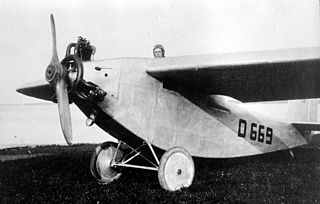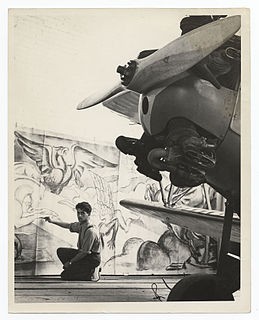
The Aquila was a nine-cylinder single-row radial aircraft engine designed by the Bristol Engine Company starting in 1934. A sleeve valve engine, its basic design was developed from the Bristol Perseus. The Aquila was never used in production, but further developments led to the Bristol Hercules, Bristol Taurus, and Bristol Centaurus.

The BMW 132 was a nine-cylinder radial aircraft engine produced by BMW starting in 1933.

The Continental R-670 was a seven-cylinder four-cycle radial aircraft engine produced by Continental displacing 668 cubic inches and a dry weight of 465 lb (211 kg). Horsepower varied from 210 to 240 at 2,200 rpm. The engine was the successor to Continental's first radial engine, the 170 hp Continental A-70. This engine was used on many aircraft in the 1930s and 1940s. The R-670 was widely used in the PT-17 Stearman primary training aircraft of the U.S. military.

Between 1920 and 1951 the Société des Moteurs Salmson in France developed and built a series of widely used air-cooled aircraft engines.

The Bristol Lucifer was a British three-cylinder, air-cooled, radial engine for aircraft. Built in the UK in the 1920s by the Bristol Aeroplane Company, it produced 100 horsepower (75 kW).

The Wright R-2160 Tornado was an experimental 42-cylinder, 7-cylinder per row, 6-row liquid-cooled inline radial aircraft engine. It was proposed in 1940 with 2,350 hp (1,752 kW) for experimental aircraft such as the Lockheed XP-58 Chain Lightning, Vultee XP-68 Tornado, and the Republic XP-69.

The Kinner K-5 was a popular engine for light general and sport aircraft developed by Winfield B. 'Bert' Kinner. With the boom in civilian aviation after Charles Lindbergh's transatlantic flight the K-5 sold well. The K-5 was a rough running but reliable engine and the K-5 and its derivatives were produced in the thousands, powering many World War II trainer aircraft. The K-5 was followed by the B-5, R-5 and R-55. Military engines were designated R-370

The Kinner B-5 was a popular five cylinder American radial engine for light general and sport aircraft of the 1930s.

Szekely aircraft engines were three-cylinder radial engines built in Holland, Michigan in the 1920s and 30s. They were used to power small aircraft such as the Rearwin Junior, Taylor H-2 and American Eagle Eaglet. Often criticized for reliability issues and design flaws, many were replaced with better engines in their original airframes. Few examples still exist but a museum quality example is on display in the Holland Museum in Holland, Michigan.

The ABC Dragonfly was a British radial engine developed towards the end of the First World War. It was expected to deliver excellent performance for the time and was ordered in very large numbers. It proved, however, to be extremely unreliable and was abandoned when its faults were unable to be corrected.

The Bristol Cherub is a British two-cylinder, air-cooled, aircraft engine designed and built by the Bristol Aeroplane Company. Introduced in 1923 it was a popular engine for ultralight and small aircraft in the 1930s.

The Blackburne Thrush was a 1,500 cc three-cylinder radial aero-engine for light aircraft produced by Burney and Blackburne Limited. Burney and Blackburne were based at Bookham, Surrey, England and was a former motorcycle manufacturer.
The Kinner C-5 was an American five cylinder radial engine for small general and sport aircraft of the 1930s.

British Salmson aero-engines refers to a series of small French designed, air-cooled radial aero engine that were produced by British Salmson Aero Engines Ltd, under license from Société des Moteurs Salmson, in Great Britain during the late 1920s and 1930s.
The KFM 112M is a four-cylinder, four-stroke, dual ignition, horizontally opposed aircraft engine designed for ultralight aircraft and motor gliders.

The Walter Pollux is a Czechoslovakian nine-cylinder, air-cooled, radial engine, built by Walter Aircraft Engines for powering light aircraft and that first ran in 1936. The engine produces 240 kW (320 hp) at 1,800 rpm.

The Walter Regulus was a Czechoslovakian five-cylinder, air-cooled radial engine for powering light aircraft that first ran in 1934. The engine produced 186 kW.

The Walter Bora was a Czechoslovakian nine-cylinder, air-cooled radial engine for powering light aircraft that was developed in the 1930s by Walter Aircraft Engines.

The Walter Castor was a Czechoslovakian seven-cylinder, air-cooled radial engine for powering aircraft that was developed in the late 1920s. The Super Castor was a nine-cylinder development. Castor I production began in 1928, Castor II in 1932 and the Castor III in 1934.
The Mathis Vega 42 was a 42-cylinder 6-bank in-line radial piston engine, designed and built in France, by Société Mathis Aviation in the late 1930s, with development continuing during and after WWII.















